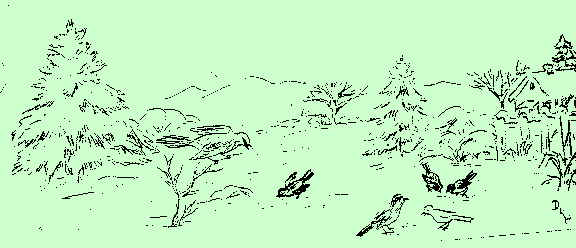|







|
. |
FEEDING BIRDS IN WINTER


 It is a pleasure to watch birds feed near your window in the winter, but
once started they must be fed all winter or they may die -- they become
dependent upon the food you put out for them. Bird feeders can be purchased
or made, be very elaborate or very simple. Wild bird seed can be purchased
at feed stores or supermarkets. Mix with bread crumbs, chopped nuts, meat
scraps, chopped suet, peanut butter (cut it in well, or it may choke the
birds), cereals and left-over grease. Sunflower seeds attract chickadees,
finches and grosbeaks. Grit (small gravel or crushed shells) should be
available. Water is welcome. Old Christmas trees piled in a corner offer
winter shelter.
It is a pleasure to watch birds feed near your window in the winter, but
once started they must be fed all winter or they may die -- they become
dependent upon the food you put out for them. Bird feeders can be purchased
or made, be very elaborate or very simple. Wild bird seed can be purchased
at feed stores or supermarkets. Mix with bread crumbs, chopped nuts, meat
scraps, chopped suet, peanut butter (cut it in well, or it may choke the
birds), cereals and left-over grease. Sunflower seeds attract chickadees,
finches and grosbeaks. Grit (small gravel or crushed shells) should be
available. Water is welcome. Old Christmas trees piled in a corner offer
winter shelter.





 The simplest type of feeder is a shelf nailed to a window sill or on a post.
Feeders should be 4 or 5 feet from the ground, with trees or shrubs nearby
for safety.
Another simple type can be made from a log about 12" long, with 1" holes
bored in it. The holes can be filled with suet, seeds, etc.
The simplest type of feeder is a shelf nailed to a window sill or on a post.
Feeders should be 4 or 5 feet from the ground, with trees or shrubs nearby
for safety.
Another simple type can be made from a log about 12" long, with 1" holes
bored in it. The holes can be filled with suet, seeds, etc.


 A submersion heater can be used to keep water in a birdbath from freezing.
Birds will drink, and even warm their toes. (Purchase from tropical fish or
poultry supply houses, or see Audubon Magazine.)
A submersion heater can be used to keep water in a birdbath from freezing.
Birds will drink, and even warm their toes. (Purchase from tropical fish or
poultry supply houses, or see Audubon Magazine.)


 A feeder with a roof keeps food dry and protects birds. Glass inserted in
grooves on sides holds several days food supply. Hinged top allows access.
A feeder with a roof keeps food dry and protects birds. Glass inserted in
grooves on sides holds several days food supply. Hinged top allows access.


 The weathervane type turns the opening away from the prevailing wind. A glass
back offers an added view of diners. A cat guard can be made from a piece
of sheet metal.
The weathervane type turns the opening away from the prevailing wind. A glass
back offers an added view of diners. A cat guard can be made from a piece
of sheet metal.


 A crocheted net or mesh bag can be used for suet. Do not use wire
containers, as they may injure a bird's eyes in freezing weather.
A crocheted net or mesh bag can be used for suet. Do not use wire
containers, as they may injure a bird's eyes in freezing weather.


 Many birds will roost in nesting houses in cold weather. Roosting boxes
with staggered quarter-inch perches will accommodate more birds.
Many birds will roost in nesting houses in cold weather. Roosting boxes
with staggered quarter-inch perches will accommodate more birds.
-- by Dorothy K. Platt

Backyard Wildlife: Feeding Birds
(University of Nebraska)
|
|

